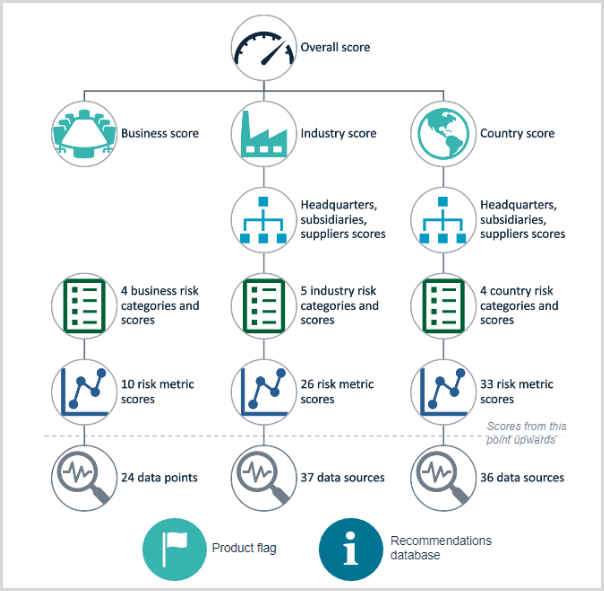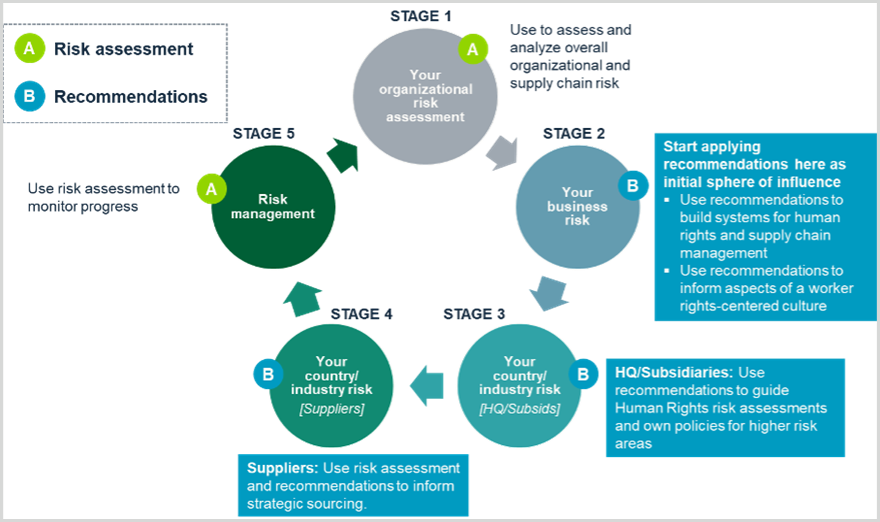Forced labor risk assessment model
A comprehensive model for organizations to assess risk exposure to forced labor and extreme labor exploitation.
Introduction
Assessing forced labor risk in an organization and its supply chain is complex. The forced labor risk assessment enables companies to highlight exploitation risk more efficiently and effectively by quantifying and explaining an organization’s risk exposure to all forms of forced labor and extreme labor exploitation. It allows companies to assess, disclose, and manage risks comprehensively across business, industry, and country-specific components, make efficient investments in risk mitigation strategies and systems, and discharge compliance obligations.
The research and logic behind the risk model have been built on world-leading Rights Lab discoveries and proprietary data, other high-quality datasets, and methods to select, construct, and standardize metric datasets, inform model algorithms, and validate outputs. There is also a complementary product risk flag analysis, providing alerts of known forced labor incidents in product supply chains. Transformation techniques allow model outcomes to be presented as risk categories and potential actions to be extracted from an insights database. The resulting model output provides organizations with detailed due diligence through a multi-factor risk assessment, expert interpretation of risk, and guidance to take meaningful action.
Model overview
The structure of the model behind the risk assessment solution is shown in Figure 1. The model provides an overall risk score consisting of three weighted sub-scores for business, industry, and country risk. The overall score and sub-scores can be further broken down across headquarters, subsidiaries, and suppliers, across risk categories, and down to individual risk metric levels. This provides extensive levels of due diligence precision, from a high-level overview to detailed analytics - the total number of risk scores available across the whole model is around 2000, representing the most comprehensive risk analysis available for forced labor.
A detailed set of potential actions for effective response accompanies the risk metric scores, providing guidance on how to mitigate risks in those specific areas. These potential actions align with global practice, including the UN Global Compact initiative, UN Guiding Principles, and International Labour Organization (ILO) guidance.
Independent of the solution’s risk scoring system, the solution will contain a product risk dataset. This dataset is an extensive record of verified, known product-country forced labor cases. The data allows you to raise alerts against problem products that may be of specific interest to an organization.
Based on these alerts of product-country combinations, your organization could consider additional work with relevant suppliers to mitigate risk or to adjust your sourcing profile where risks cannot be adequately addressed.

Figure 1: Model structure
Model design
The impacts of forced labor on economic and human development have implications for business risk and response, including slavery’s damage to productivity, multiplier effects, and innovation in production, and its relationship to illicit financial flows and environmental harm. These insights formed the basis of metrics under each model component. The business component was developed through extensive original research and literature review. The industry and country components were developed through a sustainable development lens and mapped to UN Sustainable Development Goals (SDGs).
Business risk model component
The overall business risk score combines scores across multiple categories of business practice and culture, including worker rights, governance, resilience, and transparency. These map to the internal issues that most influence forced labor risk for an organization. The score indicates, for business operations, the likelihood that severe labor exploitation, including forced labor, modern slavery, and human trafficking, may take root and persist, and the likelihood that a business has built resilience to respond to these exploitation risks.
By accessing granular scores across 10 metrics and their associated potential actions, you can consider business operations-specific interventions that protect workers, mitigate risks, and monitor conditions within your organization.
Industry risk model component
The Rights Lab’s risk model for industry spans 21 industry NACE categories. NACE is a standard industrial categorization that encompasses all economic activities.
An industry risk score combines scores across multiple categories representing the UN SDG goals that most influence forced labor risk for industries. The overall industry risk score combines industry scores across an organization’s headquarters, subsidiaries, and suppliers. The score indicates, for the combination of industries that you operate within or source from (weighted to match spend/revenue proportions), the likelihood that severe labor exploitation, including forced labor, modern slavery, and human trafficking, may take root and persist and the likelihood that resilience within industries has been built to respond to these exploitation risks.
By accessing granular scores across 26 metrics and their associated potential actions, you can consider industry-specific interventions that promote workers’ rights, mitigate risks, and monitor conditions.
Country risk model component
The Rights Lab’s country-based scoring system uses global datasets, including earth observation data within 33 key location-based metrics, to generate country risk scores across 200 countries.
A country risk score combines scores across multiple categories representing the UN SDG target issues that most influence forced labor risk for countries. The overall country risk score combines country scores across an organization’s headquarters, subsidiaries, and suppliers. The score indicates, for the combination of countries that you operate in or source from (weighted to match spend/revenue proportions), the likelihood that severe labor exploitation, including forced labor, modern slavery, and human trafficking, may take root and persist, and the likelihood that governments have built resilience to respond to these exploitation risks.
By accessing granular scores across 33 metrics and their associated potential actions, you can consider country-specific interventions that support communities linked to your operations and supply chain, mitigate risks, and monitor conditions.
Model application
Identifying the human rights risks associated with business is the first critical step in preventing and mitigating harm to people due to business activity. Organizations may conduct a forced labor risk assessment of their operations and supply chains as a core element of a human rights due diligence program, and extend the application of forced labor risk assessment to their supply base as part of a strategic sourcing cycle.
Figure 2 shows the risk assessment cycle and how the solution can be applied at each stage, using both the risk assessment and the potential actions guidance.

Figure 2: Stages of the risk assessment cycle
In self-assessment, organizations submit their own data across financial metrics and spend profiles and complete short surveys on business practice. For supply base evaluation, suppliers are requested to submit this data - this process can act as a foundation for engagement and collaboration on supply chain forced labor risks.
Summary
Taking forced labor due diligence to the next level
Regulatory, commercial, and reputational pressures on organizations to identify, manage, and address forced labor risks in their businesses and supply chains have grown exponentially. Organizations seek an evidence-driven, efficient, and reliable solution - the forced labor risk assessment can help build internal capability by providing data and insights to tackle the risk of forced labor.
For more information on how Moody's forced labor risk assessment solution can help your organization engage in leading forced labor due diligence and mitigation, contact our Client Service team.